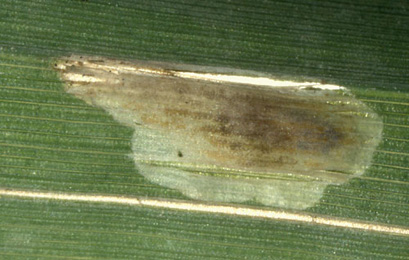|
||||||
|
ECHINOCHLOA. Millet and Cockspurs. [Poaceae] |
|
Ten species of Echinochloa are recorded in Britain. All are introduced and include Cockspur (E. crus-galli). Five British miners are recorded on Echinochloa. A key to the European miners recorded on Echinochloa is provided in Bladmineerders van Europa. Nearly 100 British miners or possible miners are recorded on grasses in Britain. It is recommended that adults of all miners on grasses be reared to be certain of their identity. |
Key for the identification of the known mines of British |
||
1a > Leaf-miner: Long upper-surface corridor usually containing several larvae that graze shoulder to shoulder from the leaf tip downwards. Pupation outside the mine. Mines and larvae are indistinguishable from those of A. nigrella. |
||
|
||
Agromyza mobilis Meigen, 1830 [Diptera: Agromyzidae]. |
||
1b > Leaf-miner: Broad elongated mine; the form is dependent of the leaf form of the host plant. Frass green. Usually a number of larvae together in a mine. Pupation in the mine. |
||
|
||
Cerodontha incisa (Meigen, 1830) [Diptera: Agromyzidae]. |
||
1c > Leaf-miner: Broad lower surface mine which generally starts at the leaf apex.The mine is somewhat irregular in depth. Frass in irregular black-green, frequently melted grains, mostly along the edges of the mine. Larva solitary. Pupation generally internal. |
||
|
||
Cerodontha muscina (Meigen, 1830) [Diptera: Agromyzidae]. |
||
1d > Leaf-miner: Upper-surface corridor, generally in the upper half of the blade, running up to the leaf tip, usually occupying more then half the width of the leaf. Frass in green stripes at either side of the corridor. Never more than one larva in a mine. Puparium within the mine, metallic black, not anchered with a string of silk. |
||
|
||
Cerodontha superciliosa (Zetterstedt, 1860) [Diptera: Agromyzidae]. |
||
1a > Leaf-miner: Irregular mine, locally shallow, elsewhere much deeper, giving it a mottled appearance. In broadleaved plants the mine often begins as a blotch with stellate extensions, but sometimes as a very fine, shallow corridor. In grasses the mine often begins in the leaf sheath. The frass is very fine-grained, initially scattered, later in aggregates. The egg is deposited on the plant surface, and the empty egg shell remains visible. But the larvae are able to leave their mine and restart elsewhere, thus mines without an egg shell can be found as well. The larva also leaves the mine before pupation. Pupation takes place in a newly made, small, blotch mine without frass; this mine may be made in another plant (species). |
||
|
||
|
||
Hydrellia griseola (Fallén, 1813) [Diptera: Ephydridae]. |
| Last updated 04-Jul-2019 Brian Pitkin | ||

